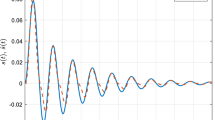Abstract
In this paper, we describe the neural fuzzy filtering properties in real-time sense; giving an approach about the real-time neuro-fuzzy digital filters, defined in acronym form as RTNFDF. This kind of filters require an adaptive inference mechanism into the fuzzy logic structure to deduce the filter answers in order to select the best parameter values into the knowledge base (KB), actualizing the filter weights to give good enough answers in natural linguistic sense. The process requires that all of the states bound into RTNFDF time limit as a real-time system, considering the Nyquist criteria. The paper shows how to characterize the membership functions into the knowledge base in a probabilistic way with respect to the rules set decisions without loss of its real-time description, performing the RTFNDF. Moreover, the paper describes in schematic sense the fuzzy neural net architecture into the filter description. This kind of filters infer from different variables related of a reference system operation at its respective operation levels, classifying it responses in order to select dynamically the best answer for the infimum error limited by the error functional, respect to each variable considered. The results expressed in formal sense use the concepts exposed in the papers included into the references. Finally, we present in illustrative manner the RTNFDF operations using as a tool the Matlab software.
Similar content being viewed by others
References
Abdul, S., Fuzzy Logic and Its Uses, http://www.doc.ic.ac.uk, 2006.
Ali, H.S., Fundamentals of Adaptive Filters, Complex Systems, 2003.
Amble, T., Logic Programming and Knowledge Engineering, Addison Wesley, 1987.
Real Analysis and Probability, Ash, R., Ed., USA: Academic Press, 1970.
Garcia, J., Medel, J., and Guevara, L., RTFDF Description for ARMA Systems, Proc. WSEAS Int. Conferences (Canada, 2007).
Gustafsson, F., Adaptive Filtering and Change Detection, John Wiley & Sons, Ltd, 2000.
Haykin, S., Adaptive Filtering, Prentice Hall, 2001.
Huang, G., Zhu, K., and Siew, C., Real-Time Learning Capability of Neural Networks, IEEE Trans. Neural Networks, 2006, vol. 17, pp. 863–878.
Buttazo, G., Hard Real-Time Computing System Predictable Scheduling Algorithms and Applications, Boston: Kluwer Academic Publishers, 1997.
Gustafsson, F., Adaptive Filtering and Change Detection, John Wiley and Sons, Ltd, 2000.
Mamdani, E., Applications of Fuzzy Algorithms for Control of Simple Dynamic Plant, Proc. IEEE, 1974, vol. 121, pp. 1585–1588.
Manuel, L., Teoría de la Medida e Integral de Lebesgue, Universidad Nacional del Rosario, 2003.
Margaliot, M. and Langholz, G., New Approaches to Fuzzy Modeling and Control Design and Analysis, World Sci., 2000.
Medel, J. and Guevara, P., Caracterización de Filtros Digitales en Tiemporeal para Computadoras Digitales, Computatión y Sistemas, 2004, vol. VII, no. 3.
Medel, J., Poznyak, A., and Guevara, P., Real-Time Multivariable Digital Filter Using Matrix Forgetting Factor and Instrumental Variable, Automatic Control and Comput. Sci., AVT, 2004, vol. 38, no. 1, pp. 40–53.
Marcek, D., Stock Price Forecasting: Statistical, Classical and Fuzzy Neural Networks, Modeling Decisions for Artificial Intelligence, Springer Verlag, 2004, pp. 41–48.
Montejo, M., Lógica Diffusa y Control Difuso, http://www.redeya.com, 2006.
Morales, G., Introductión a la Lógica Difusa, Cinvestav-IPN, 2002.
Nikola, K., Foundations of Neural Networks, Fuzzy Systems, and Knowledge Engineering, MIT Press, 1996.
Passino K.M., Fuzzy Control, Addison Wesley, 1998.
Rajen, B. and Gopal, M., Neuro-Fuzzy Decision Trees, Int. J. Neural Filters, 2006, vol. 16, pp. 63–68.
Shannon, M., A Mathematical Theory of Communications, Bell Systems Tech. J., 1948, vol. 27, pp. 379–423, 623–656.
Schneider, M. and Kandel, A., Fuzzy Expert Systems Tools, Wiley, 1996.
Takagi, T. and Sugeno, M., Fuzzy Identification of Systems and Its Applications to Modelling and Control, IEEE Trans. and Systems, Man, and Cybernetics, 1986, vol. 15, pp. 116–132.
Yamakawa, F., Fuzzy Neurons and Fuzzy Neural Networks, 1989.
Zadeh, L., Fuzzy Sets, Information and Control, 1965, vol. 8, pp. 338–353.
Author information
Authors and Affiliations
Corresponding author
Additional information
The article is published in the original.
About this article
Cite this article
Medel, J.J.J., Garcia, J.C.I. & Guevara, P.L. Real-time neuro-fuzzy digital filtering: a technical scheme. Aut. Conrol Comp. Sci. 43, 22–30 (2009). https://doi.org/10.3103/S0146411609010040
Received:
Accepted:
Published:
Issue Date:
DOI: https://doi.org/10.3103/S0146411609010040




